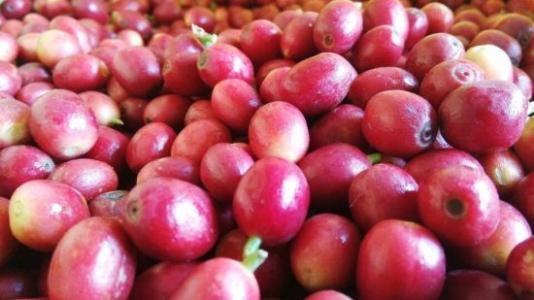Why is Brazilian coffee called the "giant" and "monarch" of the coffee world?

Old bourbon coffee is grown on some estates in Cerrado district of Minas Greais state in southeastern Brazil. These estates, such as Capin Branco and Vista Allegre, grow bourbon old-breed coffee that is also sold in the market. Although they come from the same region, these coffees have their own characteristics. Capin Blanco is softer than Vista Allegra, which is strong and dark and has lower acidity. However, like all Brazilian coffees, they are best served fresh because the older they are, the stronger the acidity. These coffee growers have organized themselves into the Speciality Coffee Association of Brazil.
Brazil has been figuratively compared to the coffee world's "giants" and "kings." There are about 3.97 billion coffee trees, and small farmers now grow 75 percent of the country's coffee. Brazil has twice or even three times as many coffee producers as Colombia, which is the world's second-largest coffee producer.
Unlike in the past, Brazil's economy is now less dependent on coffee, which accounts for only 8 - 10% of GDP. Before World War II, Brazil accounted for 50% or more of the world's coffee production, and now it is close to 30%, but the country's influence on coffee worldwide, especially on coffee prices, is significant. For example, two frosts in 1994 caused a sharp rise in global coffee prices. Coffee production has gradually become a science since the introduction of coffee trees from Guyane française (Guyana) in 1720. Before 1990, the Brazilian government strictly controlled the coffee industry, with both severe interference and price protection measures, and the state has always implemented minimum price protection measures for farmers, resulting in coffee overproduction. At one point before World War II, there were 78 million bags left in stock, which had to be burned or thrown into water. Since 1990, when the free market opened up, the former Brazilian Coffee Authority (IBC) has been replaced by a non-investment administrative body of the state, the National Economic Association, which pursues a policy of non-interference and allows producers to negotiate directly with exporters. The activities of exporters are monitored by government legislation and legal exporters are registered by the relevant authorities.
Because of the variety of Brazilian coffee, the word "Brazilian" cannot be used to describe it. Like other Arabica coffees, Brazilian coffee is called "Brazils" to distinguish it from "Milds" coffee. The vast majority of Brazilian coffee is unwashed and sun-dried, and is classified according to the state of origin and port of shipment. Brazil has 21 states, 17 of which produce coffee, but four of them produce the most, accounting for 98% of the country's total production: Parana, Sao Paulo, Minas Gerais and Espirito Santo, with Parana in the south producing the most, accounting for 50% of the total.
Although coffee is diverse, Brazilian coffee is suitable for the taste of the masses. For example: coffee produced in northern coastal areas has a typical iodine taste, reminiscent of the sea after drinking. This coffee is exported to North America, the Middle East and Eastern Europe.
Another coffee that is interesting and worth pursuing is rinsed Bahia coffee. This coffee is not easy to find, because Brazil is the world's largest coffee consumer after the United States, and many of the best coffees can only be found in its domestic market.
In Brazil, the largest crop is Robett coffee. This coffee is sold in supermarkets. Brazilian Roscoff coffee, sold under the name Conillon, accounts for 15 percent of total production.
Important Notice :
前街咖啡 FrontStreet Coffee has moved to new addredd:
FrontStreet Coffee Address: 315,Donghua East Road,GuangZhou
Tel:020 38364473
- Prev

Popular knowledge of boutique coffee beans: a brief introduction to Brazilian Bourbon Santos Coffee
The bourbon of Brazil's Bourbon Santos comes from the Bourbon Island of the Bourbon Inambek Coffee Tree (BOURBON), which is now LA RUNION, once the thriving place of Arabica coffee. The Arabica coffee tree produced on this island has been introduced to all parts of the world, and Brazil Bourbon Santos is their descendant. Brazil is the largest coffee producer in the world.
- Next

A brief introduction to the characteristics of Brazilian coffee beans the flavor and taste characteristics of coffee varieties and their treatment methods are introduced in detail.
Coffee features: Brazil, as the largest coffee producer in the country, supplies commercial beans and fine beans for the global coffee market. Instant coffee is also a critical component of coffee production in Brazil. Western coffee grows mostly at the height of 2000-3000 feet feet, about 500-100m. There is also a height of 4.
Related
- Detailed explanation of Jadeite planting Land in Panamanian Jadeite Manor introduction to the grading system of Jadeite competitive bidding, Red bid, Green bid and Rose Summer
- Story of Coffee planting in Brenka region of Costa Rica Stonehenge Manor anaerobic heavy honey treatment of flavor mouth
- What's on the barrel of Blue Mountain Coffee beans?
- Can American coffee also pull flowers? How to use hot American style to pull out a good-looking pattern?
- Can you make a cold extract with coffee beans? What is the right proportion for cold-extracted coffee formula?
- Indonesian PWN Gold Mandrine Coffee Origin Features Flavor How to Chong? Mandolin coffee is American.
- A brief introduction to the flavor characteristics of Brazilian yellow bourbon coffee beans
- What is the effect of different water quality on the flavor of cold-extracted coffee? What kind of water is best for brewing coffee?
- Why do you think of Rose Summer whenever you mention Panamanian coffee?
- Introduction to the characteristics of authentic blue mountain coffee bean producing areas? What is the CIB Coffee Authority in Jamaica?

